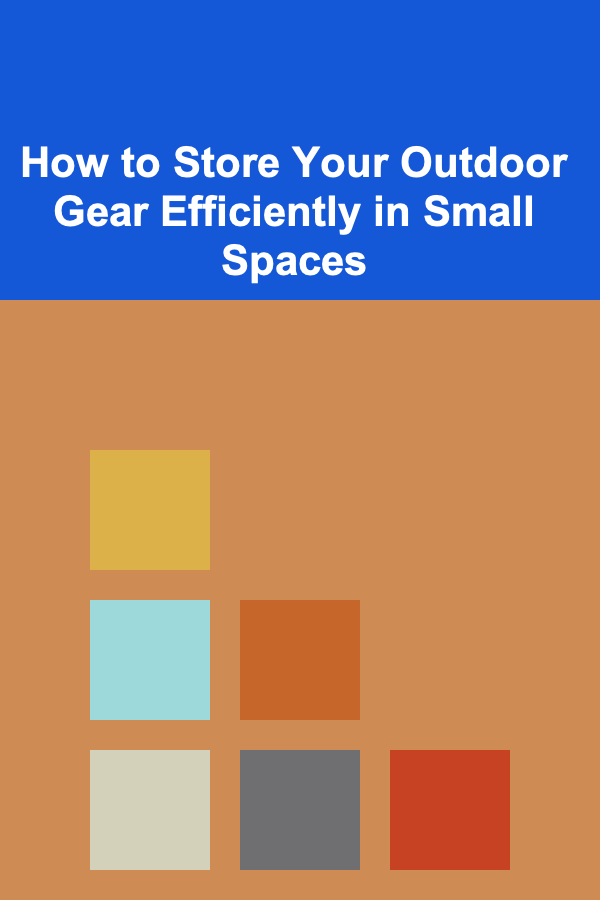
How to Store Your Outdoor Gear Efficiently in Small Spaces
ebook include PDF & Audio bundle (Micro Guide)
$12.99$11.99
Limited Time Offer! Order within the next:

Outdoor enthusiasts often face the challenge of storing their gear efficiently, especially when living in small spaces. Whether you are an avid hiker, camper, climber, or cyclist, managing your equipment can be a daunting task. With the right strategies and creative solutions, you can keep your outdoor gear organized, accessible, and safe without sacrificing valuable living space.
In this article, we will explore various methods and tips for efficiently storing outdoor gear in small spaces. We'll cover everything from assessing your storage needs to utilizing multifunctional furniture, vertical storage solutions, and innovative organization techniques. Let's dive into the world of efficient outdoor gear storage!
Assessing Your Storage Needs
Before embarking on a storage overhaul, it is essential to assess your specific needs. Take inventory of your outdoor gear to determine what you have, how frequently you use it, and the space available for storage. Here are some steps to help you evaluate your storage requirements:
1. Inventory Your Gear
Create a detailed inventory of all your outdoor gear. Categorize items based on type, usage frequency, and size. Key categories may include:
- Camping Gear: Tents, sleeping bags, cooking equipment, and portable furniture.
- Hiking Gear: Backpacks, trekking poles, hydration systems, and footwear.
- Cycling Gear: Bicycles, helmets, protective gear, and accessories.
- Climbing Gear: Ropes, harnesses, carabiners, and protective equipment.
- Water Sports Gear: Kayaks, paddleboards, life jackets, and wetsuits.
2. Evaluate Usage Frequency
Understanding how often you use each item will help prioritize storage solutions. Items that you use more frequently should be more accessible, while rarely-used gear can be stored in less convenient locations.
3. Identify Available Space
Take stock of the available storage spaces within your home. This may include:
- Closets
- Under-bed storage
- Garage or shed
- Balcony or patio
- Hooks and wall-mounted systems
4. Consider Climate and Environment
If storing items outdoors, consider environmental factors such as humidity, temperature changes, and exposure to sunlight. Gear exposed to harsh conditions can deteriorate more quickly, so appropriate protection and storage solutions are crucial.
5. Determine Budget and Resources
Lastly, assess your budget and the resources at your disposal. While some solutions might require purchasing new furniture or storage units, others could involve repurposing existing items.
Creative Storage Solutions
Once you have a clear understanding of your storage needs, it's time to explore creative solutions. Here are some effective strategies for storing outdoor gear in small spaces:
1. Vertical Storage Options
Maximizing vertical space is vital when working with limited square footage. Here are some ideas to get started:
Wall-Mounted Shelves
Installing wall-mounted shelves can create additional storage for smaller items such as hiking gear, camping cookware, or biking accessories. Use brackets to hold the shelves securely, ensuring they can bear the weight of your gear.
Pegboards
A pegboard is an excellent tool for organizing outdoor gear. Hang different tools and accessories on hooks, allowing for easy access and visibility. Paint the pegboard to match your decor for added aesthetics.
Overhead Racks
In garages or sheds, overhead racks can be utilized to store larger items like kayaks or bicycles. These racks free up floor space while keeping gear secure and out of the way.
2. Multifunctional Furniture
Consider incorporating multifunctional furniture in your living space. These pieces serve dual purposes, helping to save space while providing storage:
Storage Benches
A storage bench can serve as seating while offering ample space to store outdoor gear. Use it to hide away hiking boots, camping chairs, or seasonal clothing.
Ottomans with Storage
Ottomans that open up for storage provide a stylish solution for keeping small outdoor items organized. Use them for storing gloves, hats, or even compact camping gear.
Coffee Tables with Drawers
Select a coffee table that features drawers or hidden compartments. This can be a great spot for storing smaller items like maps, compasses, or emergency kits.
3. Under-Bed Storage
Utilize the space under your bed effectively. It's a great area for storing items that you don't need immediate access to:
Storage Bins
Clear plastic bins or fabric storage boxes can slide under the bed easily. Label these containers for quick identification of their contents.
Rolling Carts
Rolling carts can provide easy access to gear stored under your bed. They can also be moved into your living space when needed, making them versatile and convenient.
4. Closet Organization Techniques
Make the most of closet spaces by implementing organization techniques tailored to your outdoor gear:
Hanging Organizers
Use hanging organizers on the inside of closet doors to store smaller items like first aid kits, multi-tools, or electronics. This keeps them easily accessible without consuming shelf space.
Adjustable Shelving
Install adjustable shelving within closets to accommodate different sizes of equipment. Items can be arranged according to frequency of use, ensuring your most-used gear is always within reach.
Hooks and Racks
Utilize hooks and racks for hanging larger items such as backpacks, bikes, or climbing gear. This keeps your gear off the floor while making it easy to grab and go.
5. Creative Use of Baskets and Containers
Baskets and containers can be both functional and decorative in your storage system:
Wicker Baskets
Wicker or fabric baskets can serve as stylish storage options for outdoor gear. Use them to store blankets for picnics, beach towels, or small camping items.
Clear Containers
Transparent containers allow for easy visibility of your gear, making it simple to locate what you need. Label each container for an organized approach.
6. Outdoor Storage Solutions
If you have outdoor space, consider investing in storage solutions specifically designed for the outdoors:
Weatherproof Storage Boxes
Invest in weatherproof storage boxes or cabinets for items like life jackets, paddles, or garden tools. Ensure these boxes are made from durable materials that can withstand the elements.
Shed Organization
If you have a shed, use it to store larger gear. Implement shelving, hooks, and pegboards to keep everything organized and accessible.
Vertical Gardens
For those with limited outdoor space, consider vertical gardens that can serve as decorative storage for smaller items like gardening tools or camping utensils.
Organizing Your Gear
Once you've selected your storage solutions, it's important to organize your gear systematically. The following strategies can help you maintain an organized and efficient system:
1. Categorization
Organize your gear into categories based on activity or usage. This makes it easier to find what you need when preparing for your next adventure. For instance:
- Camping Equipment
- Hiking Essentials
- Cycling Gear
- Climbing Equipment
2. Seasonal Rotation
If you have seasonal gear, implement a rotation system. Keep only the gear relevant to the current season accessible while storing off-season items away. This will prevent overcrowding and make it easier to find what you need.
3. Labeling
Labeling containers, shelves, and bins can significantly enhance organization. Use a label maker or write on masking tape to clearly mark what's inside each box.
4. Regular Maintenance
Schedule regular maintenance checks to ensure your gear remains organized. Dedicate time every few months to reassess your storage system, declutter, and rearrange items as necessary.
5. Accessibility
Place frequently used items in easily accessible locations. For example, keep your hiking boots near the front of the closet or in a designated area near the door for quick access before an outing.
Safety Considerations
When storing outdoor gear, safety should always be a priority. Here are some safety considerations to keep in mind:
1. Proper Cleaning and Maintenance
Regularly clean and maintain your gear to prevent deterioration. Clean camping equipment, inspect climbing gear, and check your bicycle for wear and tear before storage.
2. Temperature Control
Store sensitive items in climate-controlled environments. For example, tents and sleeping bags should be kept in cool, dry places to prevent mold and mildew.
3. Secure Storage Solutions
Ensure that your storage solutions are secure, especially when storing items in shared spaces. Lockable boxes or cabinets can prevent unauthorized access to valuable gear.
4. Child Safety
If you have children, take precautions to ensure that your gear is stored safely out of reach. This includes sharp objects, heavy equipment, and hazardous materials.
Conclusion
Storing outdoor gear efficiently in small spaces requires thoughtful planning and creative solutions. By assessing your storage needs, utilizing vertical space, embracing multifunctional furniture, and organizing your gear systematically, you can create an efficient and organized outdoor gear storage system.
Remember that the goal is not just to find a place for your gear, but to create an environment that encourages your outdoor pursuits. With the right strategies in place, you can turn your limited storage space into a well-organized haven for your outdoor adventures.
As you embark on your next journey, whether it's hiking a new trail, camping under the stars, or cycling through scenic landscapes, the satisfaction of knowing your gear is organized and ready will enhance your experience. Happy adventuring!
Reading More From Our Other Websites
- [Home Budget 101] How to Stick to Your Grocery Budget Without Sacrificing Quality
- [Personal Finance Management 101] How to Choose the Best Apps for Personal Finance Management
- [Organization Tip 101] How to Share Your Time Capsule Journey on Social Media
- [Rock Climbing Tip 101] Knots for Safety: How to Choose the Right Knot for Different Climbing Scenarios
- [Organization Tip 101] How to Achieve a Professional Finish with a Drywall Patch Repair Kit
- [Home Family Activity 101] How to Organize a Family Dance Party in Your Living Room
- [Home Rental Property 101] How to Maximize Profit with Rentals Featuring a Screened-In Porch
- [Gardening 101] 2025 Seasonal Planting Schedule: What to Sow, When, and Where
- [Home Rental Property 101] How to Avoid Common Mistakes When Renting Out Your Property
- [Personal Investment 101] How to Understand and Invest in Index Funds for Passive Income

How to Decorate Your Home with Natural Elements for a Rustic Holiday Look
Read More
How to Improve Sound Isolation in Your Home Studio
Read More
How to Maintain Your Home's Tankless Water Heater
Read More
How to Renovate Your Home While Keeping It Childproof
Read More
How to Stage Your Home for the Spring or Summer Market
Read More
How to Master AR for E-commerce
Read MoreOther Products

How to Decorate Your Home with Natural Elements for a Rustic Holiday Look
Read More
How to Improve Sound Isolation in Your Home Studio
Read More
How to Maintain Your Home's Tankless Water Heater
Read More
How to Renovate Your Home While Keeping It Childproof
Read More
How to Stage Your Home for the Spring or Summer Market
Read More